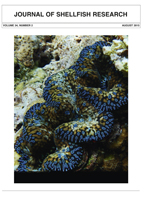The oyster pea crab Zaops ostreum (Say, 1817), is a parasite of the eastern oyster Crassostrea virginica Gmelin (1791). This study examined the frequency of occurrence and impact of pea crabs on adult (50–70 mm shell height [SH]) oysters from natural intertidal reefs in Hewletts Creek, Wilmington, NC and artificially created intertidal reefs from Jones Island, NC. The reefs at Hewletts Creek and Jones Island were also sampled in the fall of 2012 to quantify the presence of pea crabs in two cooccurring bivalve species, the scorched mussel Brachidontes exustus (Linneaus, 1758), and the ribbed mussel Geukensia demissa (Dillwyn, 1817). To evaluate the impact of pea crabs on juvenile oysters (mean SH 11.07 ± 0.16 mm), oysters were deployed in Hewletts Creek at three densities during July 2013 and then retrieved in October 2013. The percent occurrence of pea crabs in adult oysters was low on the natural reefs (1%–3.7%), greater on the created reefs (10%), whereas the percent occurrence in the deployed juvenile oysters ranged from 22.5% to 27.6%. The condition index of oysters from all treatments was significantly reduced (P < 0.05) in the presence of a pea crab; however, pea crabs did not influence (P > 0.05) oyster SH—length ratios. Juvenile oyster densities did not influence (P > 0.05) the incidence of pea crabs, although carapace width of pea crabs increased (P = 0.05) with decreased densities. On the naturally occurring reefs, pea crabs were found in scorched mussels (2.5% incidence) and ribbed mussels (2.0% incidence), but on the created reefs at Jones Island, pea crabs were only found in ribbed mussels (2.0% incidence). Results of this study highlight the impact of this parasite on the host oyster and the potential of this parasite to infect a significant portion of the younger oyster population, which may influence oyster population dynamics, as indicated by low infestation rates in adult oysters. This study also provided a quantitative foundation for understanding the prevalence of pea crabs in alternative hosts, as the pea crab population may be underestimated if multiple hosts are used.
How to translate text using browser tools
1 August 2015
Oyster Utilization and Host Variation of the Oyster Pea Crab (Zaops ostreum)
Marc H. Hanke,
James M. Hargrove,
Troy D. Alphin,
Martin H. Posey
ACCESS THE FULL ARTICLE

Journal of Shellfish Research
Vol. 34 • No. 2
August 2015
Vol. 34 • No. 2
August 2015
condition index
Crassostrea virginica
mussels
oyster
parasite—host interactions
pea crab
Zaops ostreum




